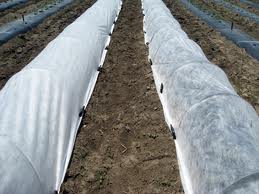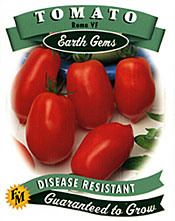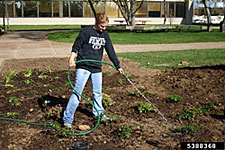Plant disease management, like most pest management, is based on several important principles. While plant disease control is often not practical or even possible, it may be possible to reduce the progress of the disease and keep it at an acceptable level. Below are the basic principles of plant disease management.
Exclusion
Exclusion of plant diseases consists of practices designed to keep pathogens (things that cause disease), vectors (things that spread disease) and infected plants out of disease-free areas. The goal of this method of management is to prevent the disease from entering the area where the plants are growing. For example, never plant diseased or infested plants. Another method is to establish plants in areas where the disease organism does not occur.
Eradication
Eradication consists of eliminating, destroying or inactivating a disease organism after it has become established. This includes:
- Destruction of infected plants
- Disinfection of storage bins, containers and equipment
- Soil disinfection by fumigation, pasteurization, solarization or drenching
Since complete eradication is not always possible or economically feasible, this control method also includes reduction of the disease organism to an acceptable level. Reducing the level of infestation involves cultural practices, such as sanitation, removing diseased plants or plant parts, rotating crops, eliminating weeds or other plants that may be alternate hosts for the disease, and discouraging or preventing insect vectors.
Protection

Row covers protecting crops.
Protection establishes a chemical or physical barrier between the host and the cause of the disease. For example, there are chemical applications available to prevent a disease from becoming established, such as fungicidal dusts and nematicides (nematode controls). Row covers that exclude insects that carry disease, fences and other physical barriers also provide protection from pests.
Resistance

This method of control focuses on planting resistant varieties. Resistance is achieved by altering the genetic system of the host to make it less susceptible to the disease organism. The tomato packet shows a strain of tomato developed to be resistant to the diseases, verticillium and fusarium wilt (VF). Some varieties are labeled "VFN" and are also resistant to nematodes.
There are two types of resistance used in plant disease management. Vertical resistance provides very high level resistance, or immunity, to specific strains of disease organisms. Horizontal resistance is a lower level of resistance, or tolerance, to many more strains of disease organisms. Both types of resistance are used in the development of agricultural crop plants. There are also many trees, shrubs, and ornamental and vegetable crops with resistant varieties on the market.
Therapy
This method of plant disease management is achieved by incorporating a chemical control agent into the physiological processes of the plant to reverse the progress of disease development after infection has occurred. Use of this principle is limited by the relatively small number of systemic materials available.
Avoidance

This landscaper is hand-watering after planting
to ensure adequate moisture.
Photo credit: William Fountain, University
of Kentucky, Bugwood.org
This method of plant disease management includes cultural practices that help avoid the potential for infection. Practices such as planting date selection, seedbed preparation and water management are cultural practices that help avoid disease. Poorly drained soils, shade and other factors can increase the susceptibility of plants to disease. Place plants properly or remove and replace problem plants with better-adapted species. Provide adequate irrigation, fertilization and space for each plant. Handle plants carefully to prevent injury, as the injury may later be the access point for a disease.
Hefner, M.
2019,
Plant Disease Management,
Extension | University of Nevada, Reno. IP


